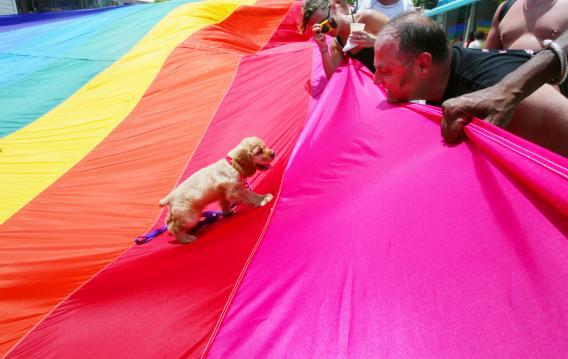A Tennessee man became convinced that his pit bull was gay when he saw the animal “hunched over” another male. He immediately gave the dog to a shelter, where it came within hours of being euthanized before being adopted. If a dog has gay sex, does that make him a gay dog?
Not necessarily. Male dogs have homosexual sex under a variety of circumstances. They mount each other in dominance displays, and that mounting can involve anal penetration. (This is probably what happened in Tennessee if, in fact, there was even sex involved.) When exposed to a female in heat, groups of frustrated males sometimes engage in homosexual sex. Neither of these behaviors suggests a permanent preference for members of the same sex. There are, however, male dogs that show a lifelong indifference to estrous females and never have heterosexual sex. It’s difficult to say whether this should be equated with the human concept of being gay. No one knows what’s in the mind or heart of a dog.
The Tennessee pit bull owner, although widely derided, was participating in a longstanding tradition: Humans have long associated dogs with gay sex. Classicist Robert Graves wrote about the Enarieae, pagan priests in the pre-Christian Eastern Mediterranean who engaged in sodomy to celebrate the rising of Sirius, the dog star. Canines have been the target of man’s homophobia for just as long. The Old Testament describes male prostitutes as dogs. In the King James Version, Deuteronomy 23:18 admonishes against bringing “the price of a dog into the house of the Lord.” In the New International Version, the Hebrew word for “dog” is translated as “male prostitute” to clarify the ancient euphemism.
Mankind probably associated dogs with homosexuality simply because they had so many opportunities to observe canine copulation. If our ancestors had been exposed to a little more ram or albatross sex, dogs may have escaped their prejudices. Approximately 6 percent of rams court and have sex with other males and do not respond to female sheep in heat. Same-sex, long-term pair bonding is fairly common among some bird species. Male-male penguin couples have become a fascination among zoo-goers. A pair in New York adopted an egg and became successful parents. Female albatross pairs seem to view males as little more than sperm donors, getting pregnant and then immediately returning to the female partner. It may even be possible to influence sexual preference in some species. Guppies raised in all-male tanks get used to courting one another and are less likely to mate with females later in life. The same phenomenon has been observed in blue-tailed damselflies. Zebra finches administered synthetic hormones are more likely to form same-sex couples.
Evolutionary biologists have struggled to explain why a dog, ram, or bird might develop a seemingly durable preference for members of the same sex. Most evolutionary theories of homosexuality focus on discrete homosexual acts rather than a homosexual nature. Gay sex may strengthen bonds between members of a community or serve as practice for young, sexually inexperienced individuals. In some species, like the striped goodea fish, lower-ranking males develop characteristically female body markings to lessen the likelihood that powerful males will attack them. Those changes sometimes attract male sexual attention. But, even in this case, the subordinate males usually engage in heterosexual sex when the opportunity arises. A potential explanation for long-term homosexuality is that childless individuals can play an important role in rearing a community’s young—an evolutionary beneficial form of selflessness.
Got a question about today’s news? Ask the Explainer.
Explainer thanks Marlene Zuk of the University of Minnesota.
